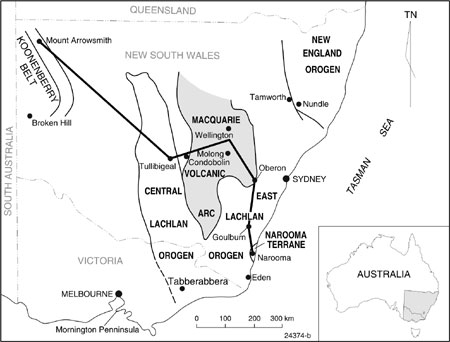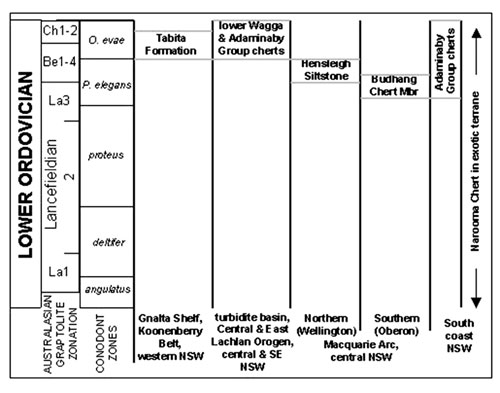
Early Ordovician geography of East Gondwana
Ian G. Percival1 and Richard A. Glen2
1 Geological Survey of New South Wales, P.O. Box 76, Lidcombe, N.S.W. 2141, Australia and Honorary Research Associate, MUCEP, Macquarie University, N.S.W. 2109, Australia. E–mail: percivai@minerals.nsw.gov.au
2 Geological Survey of New South Wales, P.O. Box 536, St Leonards, N.S.W. 1590, Australia. E–mail: glenr@minerals.nsw.gov.au
Key words: Conodonts. Early Ordovician. Terranes. Paleogeography. Australia.
Introduction
During the Ordovician, the Australian craton formed part of east Gondwana with its margin, located between approximately 10 and 20 degrees north, facing the Proto–Pacific Ocean. Early Ordovician cratonic margin shelfal sediments are today exposed in the far northwest corner of present–day New South Wales (N.S.W.), and in western Tasmania. Eastwards the cratonic margin is flanked by a complex of terranes (collectively known as the Tasmanides), representing an offshore volcanic island arc, deep marine turbidite–infilled basins, and an oceanic terrane, all of which were subsequently accreted to the craton. Although today the preserved remnants of this paleogeography extend across a distance of less than 1000 kms, crustal shortening of the region suggests the original distance involved may have been three or more times greater. Here we supplement a recent detailed analysis of the Ordovician biogeography of Australasia (Webby et al., 2000), using newly documented occurrences in N.S.W. of conodonts of the upper Prioniodus elegans and succeeding Oepikodus evae zones (Percival et al., 2003) to constrain correlations.
Cratonic margin
Following the Delamerian deformation in late Middle to Late Cambrian time, Lower Ordovician sedimentary successions developed on top of Neoproterozoic and Early Cambrian crust in far western N.S.W., and on Early Cambrian crust in western Victoria. The cratonic basement of the Gondwanan supercontinent is exposed along the Koonenberry Belt, that extends east and north of Broken Hill (Figure 1). Here, Ordovician sediments represent remnants of an extensive shallow marine depositional setting, the Gnalta Shelf (Webby, 1976: figure 6B, 1983: figure 1). At the north–western extremity of the Koonenberry Belt, the youngest fossiliferous horizon in the Lower Ordovician Mootwingee Group which is exposed at Mount Arrowsmith and nearby Koonenberry Gap, yields a diverse conodont fauna (30 species) of Oepikodus evae Zone age (Zhen et al., 2001, 2003). Contemporaneous conodont faunas have been described from the Horn Valley Siltstone of the Amadeus Basin (Cooper, 1981), and the Coolibah Formation of the Georgina Basin (Stait and Druce, 1993). These depocenters were linked by the Larapintine Sea which provided a shallow marine connection from the Gnalta Shelf through central Australia, westwards to the Canning Basin (Webby et al., 2000: figure 6).
Turbidites in offshore basins (Adaminaby Superterrane)
Extensive quartz–rich turbiditic successions in the Lachlan Orogen, derived from the eroding Gondwana craton to the southwest (Ross Orogen in Antarctica) and west (Delamerian Orogen in South Australia), accumulated in deepwater basins behind an intraoceanic island arc, the Macquarie Arc (Glen and Percival, 2002). The presence of similar quartz–rich turbidites (Adaminaby Group) located south and east (‘outboard’) of these arc rocks, coupled with the absence of volcanoclastic detritus and the presence of faulted relationships with arc rocks, implies that they developed independently as separate terranes (Glen et al., 1998), and were structurally moved into a forearc location (Glen and Percival, 2002).
Until recently, definitive evidence of Early Ordovician turbiditic sedimentation has been lacking over much of the region, but conodonts of this age have now been recognised in cherts from the Tullibigeal area west of Condobolin, and from cherts in the Boorowa–Gunning–Goulburn region of southeast N.S.W. (Percival et al., 2003). These occurrences lie within the undifferentiated lower parts of the Wagga and Adaminaby Groups respectively, where thin (3–4 cm) discrete chert beds are interspersed in a siltstone or sandstone–dominated succession. Comparable Early Ordovician (Bendigonian–Chewtonian) conodonts have previously been identified (Stewart and Glen, 1991) within the Adaminaby Group on the far south coast of N.S.W. near Eden (Figure 1).

Figure 1. Locality map, SE Australia (New South Wales and Victoria), showing sites mentioned in text plus major Ordovician tectonic units; transect line for correlations in Figure 2 is also indicated.

Figure 2. Correlation of Early Ordovician successions across New South Wales.
Volcanic islands of the Macquarie arc
Throughout the Ordovician, the Macquarie Arc was an intraoceanic island arc positioned possibly a thousand kilometres to the east of the Gondwanan margin. It was split into several structural belts by middle Paleozoic rifting (Glen et al., 1998). Age control in Early Ordovician sediments deposited on and around volcanic islands forming the Arc is provided by isolated occurrences of conodonts and graptolites. In the northern sector of the central part of the Arc (Molong Volcanic Belt of Glen et al., 1998), now located between Wellington and Molong (Figure 1), the Hensleigh Siltstone yields conodonts of Prioniodus elegans Zone age from allochthonous limestones and autochthonous laminated carbonates (Zhen et al., 2001, in press b), together with associated early–middle Bendigonian graptolites in the upper part of this formation (Percival et al., 1999).
Further evidence of Early Ordovician sedimentation at the southern extremity of the Molong Volcanic Belt, between Cowra and Boorowa, comes from chert clasts incorporated in a conglomerate in the Late Ordovician Kenyu Formation. These clasts contain the conodonts Oepikodus evae and Paracordylodus gracilis, and presumably represent erosional remnants of a late Bendigonian deep–water succession which has been recycled into younger rocks.
Another Early Ordovician deep–water conodont assemblage, probably of late Lancefieldian to early Bendigonian age (Murray and Stewart 2001) has been obtained from the Budhang Chert Member near Oberon, today situated approximately 140 kms SE of the Hensleigh Siltstone outcrop (but probably closer before rifting of the arc in the Silurian–Devonian). Stratigraphic relationships are less clear in this area, but it is apparent from the regional context that this area lies near southern end of the Rockley–Gulgong Volcanic Belt (Glen et al., 1998) and hence most likely also represents part of the intraoceanic volcanic island complex of the Macquarie Arc.
One occurrence of Early Ordovician strata, approximately contemporaneous with the Budhang Chert Member, is known from the western–most of the volcanic belts comprising the Macquarie Arc. The Yarrimbah Formation, exposed west of Parkes, and consisting mainly of deep–water siliceous siltstones, is dated on the basis of graptolites (Sherwin, 1979) as late Lancefieldian to early Bendigonian.
Narooma Terrane (oceanic)
Exposed in the vicinity of Narooma on the south coast of N.S.W. (Figure 1), and in fault contact with the Adaminaby Superterrane, lies the Narooma Terrane. This oceanic terrane is dominated by deep sea chert which accumulated over about 50 million years (Glen et al., 2002; Glen and Percival, 2002). It migrated westwards approximately 2500 kms on the Proto–Pacific Plate before accreting to east Gondwana in latest Ordovician to Early Silurian time. Conodont faunas ranging in age from Late Cambrian to late Middle Ordovician/early Late Ordovician (Darriwilian/Gisbornian) are known from the Narooma Chert (Stewart and Glen 1991), although sedimentation may not necessarily be continuous over this interval. Early Ordovician conodonts present are indicative of a probable Bendigonian age (Prioniodus elegans Zone).
New England orogen
Only sparse evidence is so far known of Early Ordovician sedimentation in the New England region, in the northeast corner of N.S.W., and neither of the two occurrences recorded, in the Tamworth–Nundle area, has been fully documented. Packham (1969: p. 231) reported collection of small pendent forms of the graptolite Didymograptus "close to D. minutus" which he considered to be of probable Bendigonian age. Furey–Greig (1995) listed an occurrence of the conodont Variabiloconus cf. bassleri in the Haedon Formation, presumably also of Early Ordovician age although no further details were provided of locality or stratigraphic horizon.
Conclusions
Recognition of Early Ordovician conodonts of the P. elegans and O. evae zones enhances precise correlation across N.S.W. (Figure 2) from the cratonic margin of east Gondwana (Koonenberry Belt), eastwards into terranes of the Proto–Pacific ocean (Adaminaby Superterrane, Macquarie Arc, and Narooma Terrane). Such precision in age control is essential to modelling tectonic reassembly of this segment of east Gondwana.
Acknowledgements
We thank reviewers C. R. Barnes and G. L. Albanesi. Published with permission of the Director General, NSW Department of Mineral Resources. This is a contribution to IGCP Project 436.
References
Cooper, B.J. 1981. Early Ordovician conodonts from the Horn Valley Siltstone, central Australia. Palaeontology, 24(1): 147–183.
Furey–Greig, T. 1995. The "Nemingha" and "Loomberah" limestones (Early Devonian; Emsian) of the Nemingha–Nundle area, northern New South Wales: conodont data and inferred environments. Courier Forschungsinstitut Senckenberg, 182: 217–233.
Glen, R.A. and Percival, I.G. 2002. Ordovician terranes in the Lachlan sector of the East Gondwana margin. Abstracts volume, IGCP436 meeting, Christchurch, New Zealand, August 2002.
Glen, R.A., Stewart, I. and Percival, I.G. 2002. The Narooma Terrane: implications for the construction of the outboard part of the Lachlan Orogen. AGC2002, Geological Society of Australia, Abstracts 67: 119.
Glen, R.A., Walshe, J.L., Barron, L.M. and Watkins, J.J. 1998. Ordovician convergent–margin volcanism and tectonism in the Lachlan sector of east Gondwana. Geology, 26: 751–754.
Murray, S.I. and Stewart, I.R. 2001. Palaeogeographic significance of Ordovician conodonts from the Lachlan Fold Belt, southeastern Australia. Historical Biology, 15: 145–170.
Packham, G.H. (ed.). 1969. The Geology of New South Wales. Journal of the Geological Society of Australia, 16(1): 1–504.
Percival, I.G., Morgan, E.J. and Scott, M.M. 1999. Ordovician stratigraphy of the northern Molong Volcanic Belt: new facts and figures. Geological Survey of N.S.W., Quarterly Notes, 108: 8–27.
Percival, I.G., Zhen, Y.–Y. and Webby, B.D. 2003. Early Ordovician conodont distribution from craton to basin and island terranes in east Gondwana. (This volume).
Sherwin, L. 1979. Age of the Nelungaloo Volcanics, near Parkes. Geological Survey of N.S.W., Quarterly Notes, 35: 15–18.
Stait, K. and Druce, E.C. 1993. Conodonts from the Lower Ordovician Coolibah Formation, Georgina Basin, central Australia. BMR Journal of Australian Geology and Geophysics, 13: 293–322.
Stewart, I.R. and Glen, R.A. 1991. New Cambrian and Early Ordovician ages from the New South Wales south coast. Geological Survey of N.S.W., Quarterly Notes, 85: 1–8.
Webby, B.D., 1976. The Ordovician System in south–eastern Australia. In: Bassett, M.G. (ed.), The Ordovician System: proceedings of a Palaeontological Association symposium, Birmingham, September 1974. Cardiff, University of Wales Press and National Museum of Wales: 417–446.
Webby, B.D., 1983. Lower Ordovician arthropod trace fossils from western New South Wales. Proceedings of the Linnean Society of New South Wales, 107: 61–76.
Webby, B.D., Percival, I.G., Edgecombe, G.D., Cooper, R.A., VandenBerg, A.H.M., Pickett, J.W., Pojeta, J., Playford, G., Winchester–Seeto, T., Young, G.C., Zhen, Y–y., Nicoll, R.S., Ross, J.R.P. and Schallreuter, R. 2000. Ordovician palaeobiogeography of Australasia. In Wright, A.J., Young, G.C., Talent, J.A. and Laurie, J.R. (Eds.), Palaeobiogeography of Australasian Faunas and Floras. Memoir of the Association of Australasian Palaeontologists, 23: 63–126.
Zhen, Y.Y., Nicoll, R.S., Percival, I.G., Hamedi, M.A. and Stewart, I. 2001. Ordovician rhipidognathid conodonts from Australia and Iran. Journal of Paleontology, 75: 186–207.
Zhen, Y.Y., Percival, I.G. and Webby, B.D. 2003. Early Ordovician conodonts from far western New South Wales, Australia. Records of the Australian Museum. 55(2): 169–220.
Zhen, Y.Y., Percival, I.G. and Webby, B.D. In press. Early Ordovician (Bendigonian) conodonts from central New South Wales, Australia.
Received: February 15, 2003
Accepted: June 15, 2003